According to recent reports, wealthy people are three times more likely to receive EMV chipped debits and credit cards than lower income individuals. CreditCards.com suggests that the gap exists in large part due to the way banks have chosen to roll out the new cards. But will this method put lower income card owners at risk? Some credit experts say that it may.
Many banks have chosen to roll out rectangular-chip-embedded cards to customers that travel internationally first. Customers who travel internationally are generally those who earn a higher income and can afford to travel on a regular basis. Cards are also being rolled out to consumers who use them at retailers with compatible card readers, many of which are higher end retailers. A poll of 1,038 U.S. adults revealed that 46 percent of those who make more than $100,000 per household reported that they already have an EMV chip, as opposed to 13 percent of individuals who make less than $35,000.
Still these figures are expected to jump this year, as banks are pushing out more EMV chipped cards to meet the October 15 deadline. However, most experts note that even if the banks crank up EMV chip distribution, millions of credit card owners will still be without extra anti-fraud protections in 2016.
Over 80 countries have been using EMV chips for years. The technology is said to drastically reduce instances of fraud, due to chip technology. Some security minded consumers do not want to wait for banks to roll out EMV cards. In most cases, customers can call their credit card company and place a request for a EMV enabled card for no charge.
By the end of 2015, an estimated 50 to 70 percent of Americans are slated to have EMV chip cards. EMV chip cards will become the standard for all merchants and payment processors. Ensure that your business is ready to process EMV chip cards by opening a high risk merchant account with eMerchantBroker.com. We can get your merchant account set up and running within 48 hours.


